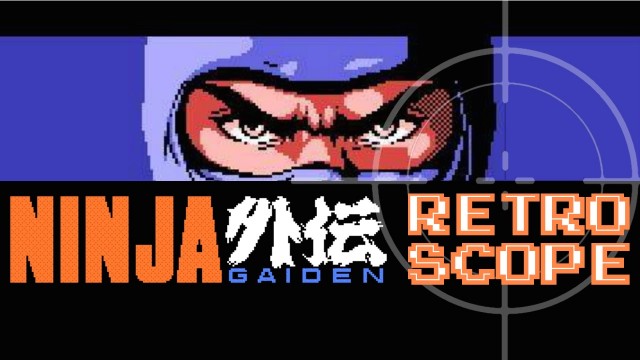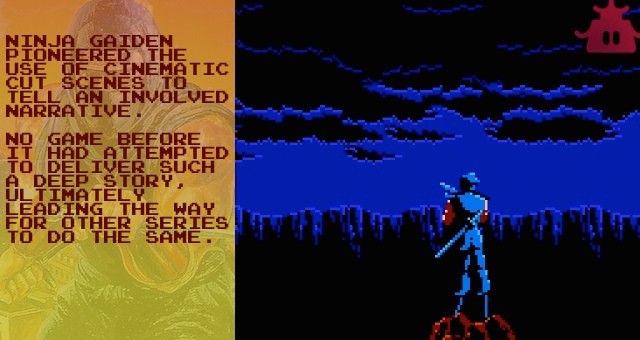
By the mid 1980s, video game developer Taito’s Double Dragon was the king of arcade brawlers, creating a ton of buzz with fans and sucking up quarters like a vacuum cleaner. Tecmo, a competing development studio, was anxious to capitalize on Double Dragon’s success with its own, similar franchise. Tecmo set its Team Strong, led by Shuichi Sakurazaki (also known as Hideo Yoshizawa, the creator of Klonoa! Japanese development studios at this time were famous for listing their employees under pseudonyms in order to keep competitors from poaching their talent), to develop a game to stand toe-to-toe with Taito’s hit. Starring Ryu Hyabusa, 1988’s Ninja Gaiden was a challenging beat ’em up that mimicked Double Dragon, but established its own identity.
Tecmo’s management was pleased with the title being a hit in arcades, but knew that Ninja Gaiden was destined for more. In the late eighties, anything that saw success in the arcade was given serious consideration to be ported to Nintendo’s blockbuster gaming console, the Nintendo Entertainment System, which is exactly what Tecmo intended to do with Ninja Gaiden. Sakurazaki was brought back, this time to be in charge of development of the NES version, but he had plans for Ninja Gaiden far beyond a simple port.

In a surprise move, Sakurazaki threw out almost everything from the arcade version of Ninja Gaiden, save for its lead character. Rather than remain a brawler, the game became an action-platformer. Sakurazaki also incorporated an assortment of new weapons to make Ryu as lethal as possible. The ninja’s set of moves was diverse and made combat immensely satisfying. While the gameplay alone was fun and fast-paced, it was something else that Sakaurazaki added to Ninja Gaiden that would really cement its place in gaming history.
Midway and Namco’s Ms. Pac-Man was the first video game to have ever used cut scenes, and Nintendo’s Donkey Kong was the first title to introduce a structured narrative. What Ninja Gaiden brought to the table that hadn’t been seen before, however, was a heavy use of cinematic cut scenes to tell an involved (though confusing) story between levels. This deliberate, stylized focus on narrative was different than anything gamers had experienced on a home console up to that point. Fans were sucked in by the captioned imagery, which is somewhat reminiscent of modern motion comics. Ninja Gaiden is important for laying the groundwork for future innovations in storytelling in video games, including series like Metal Gear Solid.

Beyond fun gameplay and an engaging story, Ninja Gaiden is also known for being gut-wrenchingly difficult. The game chewed up and spat out players who couldn’t keep up. Like the Mega Man series, though, Ninja Gaiden is tough but fair. Again like Capcom’s blue bomber games, mastering Ninja Gaiden is all about practice and pattern recognition. Players who familiarized themselves with the game’s intricacies were treated to tricky enemy types and creepy, hulking bosses. Ninja Gaiden was also similar to Castlevania, as well, in that it offered a more mature gaming experience on NES that appealed to older gamers. Its solid visuals and dark tone have made Ninja Gaiden remain as fun today as when it debuted.
Players weaned on Tomonubu Itakagi’s reinvention of the series might think the classic NES version of Ninja Gaiden to be too tame, but they’d be mistaken. While not a bloodbath by any means, Ninja Gaiden is as immersive and kinetic as its Xbox brother. Ryu was last scene in the divisive Ninja Gaiden 3: Razor’s Edge on Wii U, but the original trilogy of Ninja Gaiden games is available on the 3DS eShop (original, only, is on the Wii U one) for those interested. It’s a series that can sometimes be overlooked when discussing the great titles of the history of video games, but very much deserves to be part of the conversation.




 ShareThis
ShareThis






I hadn’t known about Ninja Gaiden being changed from an arcade brawler into the action game we all know and love. Thanks for the history lesson!
I guess Ninja Gaiden belongs to that small group of NES games that were both drastic departures AND improvements from/over their original arcade versions: Bionic Commando, Rygar, Castlevania (If you count “Haunted Castle”), Punchout, Contra, etc.) I’m sure there are more….
Still waiting for a US WiiU virtual console release for both parts two and three (Europeans have the complete trilogy!)
Parts 2 and 3 are in on the 3DS VC if you can’t stand the wait. I’m seriously considering them also, thanks to this retrospect.
Thanks for catching my error, you two-I updated the article to note the actual availability of the original games. =)